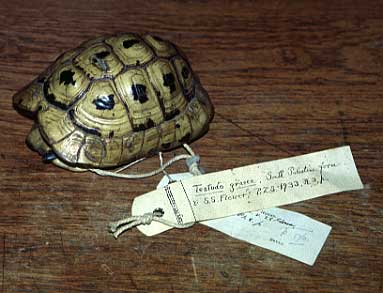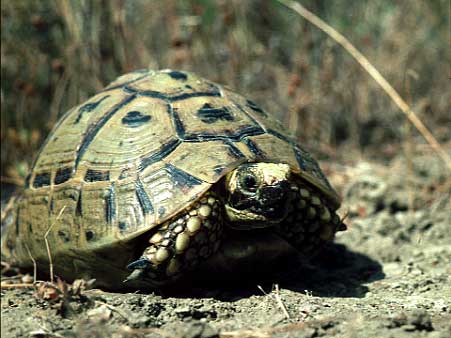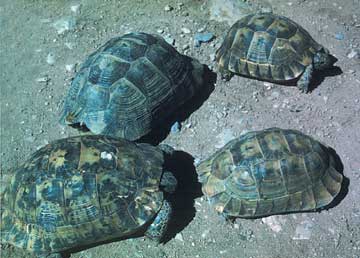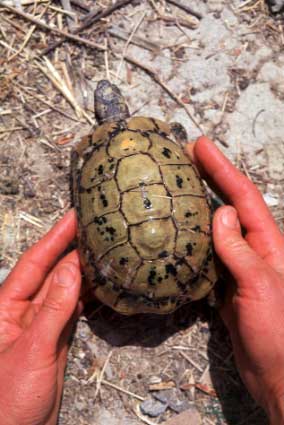
![]() The Mystery of the Golden Greeks
The Mystery of the Golden Greeks
The influence of environment upon coloration and size in tortoise populations
A. C. Highfield

The holotype of Testudo floweri -is this an example of an ecological morph?
In recent years a great deal of interest has been expressed
over a group of Mediterranean spur-thighed tortoises that are often described
by dealers as ‘Golden Greeks’. The first point to make is that none of these
tortoises arise in
The answer is to be found by comparing the climates of the zones where these animals are found. Without exception, these tortoises occur in very hot, dry and arid regions that experience unusually high temperatures during summer. Temperatures in these regions from late spring to early fall are typically so high that normal tortoise activity is severely reduced, if not suspended entirely. In many cases, the endemic tortoise populations resort to the strategy of continual estivation during the hottest, driest months in order to survive the extreme heat and lack of food.

Testudo ibera - Antakya, Turkey
In conditions such as these, being bright yellow (and hence, highly reflective to solar radiation) confers a number of important advantages. It extends the permissible period of activity. Getting the animal’s body raised to satisfactory levels for normal activity is not typically a problem in these regions; instead, avoiding overheating is a more frequent issue.
One should think here in terms of two hypothetical tortoises: one highly melanistic (black) and the other bright yellow with very few dark markings. If both animals are placed beneath an identical radiant heat source, the black specimen will gain heat far more rapidly than the bright yellow example due to the vast disparity in reflectance. We have all experienced what can happen to the metal of a black car in the mid-day sun compared to a white vehicle in identical conditions. Tortoises are no different. The same laws of physics apply. A pure black body, by definition, would absorb radiation completely in all wavelengths and reflect nothing. There is no such thing as a perfect reflector, but a silvered mirror is fairly close to this ideal. Because incident radiation is either absorbed or reflected, absorptivity and reflectivity must always add to 100%. If 60% of radiation is reflected, 40% is absorbed, and so on. A tortoise we perceive as yellow reflects mostly yellow light and absorbs other wavelengths. A tortoise we perceive as black absorbs a far wider range of wavelengths. Approximately half of the energy of solar radiation falls within the visible light spectrum, and therefore shell and skin coloration exerts a major effect upon the rate of heating. At its most simplistic, then, this is the key to understanding why some tortoises are highly melanistic and others are almost completely lacking in this respect.
The reality is slightly more complex in practice, however, as thermoregulation is not the sole factor that influences the desirability (or otherwise) of a particular color or shade. The demands of protective coloration (camouflage) may sometimes compete with thermal advantages. Most species therefore evolve a compromise solution that while not entirely optimum for either requirement, is at least functionally acceptable in terms of both needs. This particular characteristic is well known in certain species of snake, for example. Many rattlesnakes have evolved a ground color and pattern that closely mimics their preferred substrates. It also needs to be realized that there are two distinct aspects to this question of absorption and reflectance: the visible spectrum, and the invisible spectrum (infra-red and UV wavelengths). Some reptiles have developed quite complex and advanced solutions in that they closely match their chosen habitat and substrate in the visible spectrum, but differ considerably from that substrate in terms of invisible spectrum absorption and reflectance. While this phenomenon has been little studied with regard to tortoises specifically, it is well known in other reptiles (Norris, 1967, Pearson, 1977).
There is absolutely no doubt that many tortoises adopt a shell and skin coloration that is plainly designed to blend into their natural habitats. One of the most striking examples of this within my personal experience is certain populations of Testudo graeca graeca (Mediterranean spur-thighed tortoise) in the Atlas Mountains of Morocco. Here, the rocks and soil are rich in iron, and are a deep ochre-red color. This very same shade is seen on the skin and carapaces of tortoises in this region. As soon as one leaves this particular geological zone, the tortoises revert to a more ‘normal’ coloration for this species. Other Mediterranean tortoises that display similar correlations to substrate color include the Libyan ‘Testudo graeca’ populations (Testudo graeca cyranaica) and Libyan origin Testudo kleinmanni.
Altitude has a profound influence upon optimum heating and
cooling rates. In general, tortoises from higher altitudes experience substantially
lower temperatures, and higher wind-chill factors, than do animals from lowland
or coastal zones. We would therefore expect tortoises from higher altitudes to
be darker overall than the same tortoises living at lower, warmer altitudes.
This is in fact the case. Again referencing

Testudo graeca graeca - Azrou, High Atlas Mountains
Even within the same species, then, differences in shell and skin reflectivity (in both the visible and invisible spectrums) tend to correlate very closely with habitat and substrate type and with local environmental conditions. The same phenomenon has again been reported in lizards and in snakes (Talbot and Livezey, 1963; Coleman and Livezey, 1968).
Body size, and indeed shape, also exerts a marked influence upon thermoregulatory behaviors, and in turn is (to varying degrees) dictated by environmental influences via evolutionary processes. Exchange of heat with the environment occurs through the mechanism of the body surfaces, and all other factors being equal (which in reality, they rarely are), the greater the surface area of the body the greater its heat gain or loss compared to a smaller animal subjected to identical thermal conditions. In addition, roughly spherical objects exhibit a very different ratio of surface area to mass than do elongate objects. The more surface area is exposed relative to mass, the greater the degree of thermal coupling to the local environment.
For a tortoise, where excess heat gain is the primary environmental obstacle to overcome, therefore, it makes perfect sense to evolve a small body size, and preferably, an approximately spheroid body form. For species living in geographical zones where getting sufficiently warm is more problematic, a larger body size and a more elongate form offers distinct advantages. We find these much larger animals not only at higher altitudes, but also in forest habitats where direct radiant heat is moderated by the canopy of vegetation.
A smaller size also makes it easier to take advantage of what limited shade may be available. A smaller tortoise can more easily shelter from extreme heat. A larger animal may be quite unable to secrete its body in a convenient ‘scrape’ or under whatever sparse shelter may be available.
A survey of tortoises from specific locations clearly
suggests that these mechanisms are indeed behind the often confusing range of
colors, body sizes and shapes of different populations of Mediterranean
tortoises. We find very small, brightly colored, almost amelanistic animals
most frequently in geographical zones that are extremely hot and arid.

Testudo graeca graeca - Sorbas Basin, Spain
By contrast, we find a predominantly larger, darker colored animal
in high altitude and Northern areas of the range. It should be understood that
the properties of coloration and size transcends species definitions. One finds
small, yellow Testudo graeca graeca (
This is far from a unique phenomenon, and is certainly
mirrored by many other reptiles. Populations of Liolaemus lizards in the high
In conclusion, there is an almost perfect correlation between habitat types, substrate properties, local climatic conditions, and a tortoise’s body size, shape and coloration. In turn, one finds behavioral modifications that reflect these properties and conditions. Once again, one is left in some considerable awe of the abilities of these remarkable creatures to ‘find their niche’ in whatever environment nature allots to them.
This situation gives rise to many questions, particularly
with regard to the taxonomic status, or classification of animals, when
geographical and climatic factors have caused them to diverge so markedly from
neighboring populations. The environment affects its inhabitants; those who can
work with it survive to produce offspring. Sometimes the effect of the
environment is enormous, changing body composition; other times, it just
changes the color of the animal. In time, survivability of the fittest (those
most suited to the environment survive, those ill-suited tend not to survive to
breeding age) has the effect of shifting the dominant physical characteristics
of the entire population over to the most appropriate model. At this point, we
may determine that the shift is sufficient to warrant separate taxonomic
recognition. Even within such populations, however, it is not unusual to find
the odd specimen exhibiting a recessive trait. For example, in the bright
yellow population of Testudo ibera located in the region of
In terms of practical management, with a realization of the habitat types that these ‘Golden Greeks’ originate from, we can conclude that they require low humidity maintenance, with a relatively dry substrate, should be offered opportunities for self-regulation of their microclimate via burrowing, and should be maintained at relatively high temperatures. Because of their reduced ability to absorb radiant energy compared to more melanistic tortoises, extra assistance may be required where they are to be maintained in Northern or cooler climates. One important thing to recognize in the midst of all this basic physics is that although a black and a yellow tortoise certainly heat up at different rates when exposed to identical levels of solar radiation, their rate of cooling is little affected by external color differences. Heat, in this instance, is lost via radiation in the infrared spectrum, and this is not affected at all by coloration in the visible light spectrum. Although our black and yellow tortoises will gain heat at different rates, therefore, they will lose it at almost identical rates irrespective of their shell patterns or coloration.
References:
Coleman. P. R. and Livezey, R. L. (1968) Infrared reflection of the integument of live Sceloporus occidentalis occidentalis Baird and Girard from three habitats. J. Herpetology 1:71-75
Norris, K. S. (1967) Color adaptation in desert reptiles and its thermal relationships. In: Lizard Ecology: A symposium, pp. 162-229.
Pearson, O. P. (1977) The effect of substrate and of skin color on thermoregulation of a lizard. Comparative Biochemisty and Physiology. 58A:353-358
Talbot, H. E. and Livezey, R. L. (1963) Intergumental reflectivity of live Sceloporus occidentalis occidentalis from four habitats. Herpetologica 19:269-74
(c) A. C. Highfield 2002